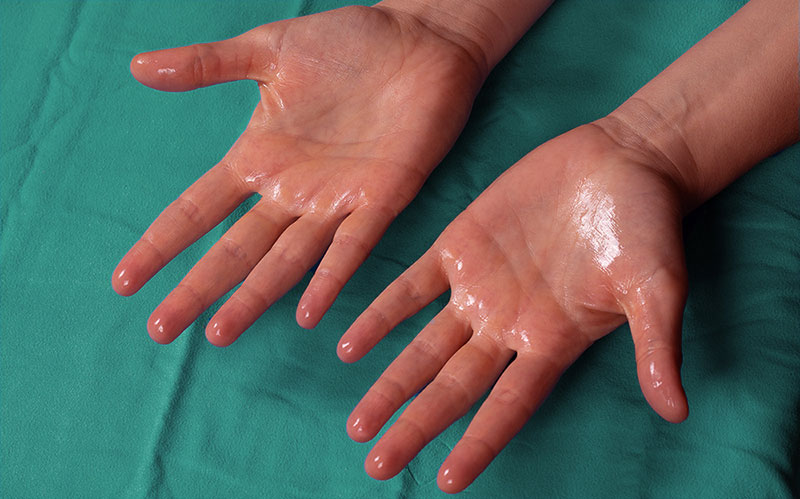Top Dermatology Treatments for Hyperhydrosis of Hands and Feet: What You Required to Know
Unveiling the Complexities of Excessive Sweating: A Comprehensive Guide to Diagnosis and Management
Extreme sweating, medically referred to as hyperhidrosis, is a condition that affects a substantial number of people and can have a profound impact on their lifestyle. While sweating is a natural physical feature, its overactivity in hyperhidrosis presents a special collection of difficulties that frequently go past plain pain. Understanding the underlying reasons, recognizing the signs, and browsing the analysis process for hyperhidrosis can be detailed jobs. In this comprehensive overview, we will explore the complexities of hyperhidrosis, from its medical diagnosis to the array of treatment alternatives readily available, clarifying efficient monitoring methods for those facing this condition.

Comprehending Hyperhidrosis Causes
Hyperhidrosis causes can be associated to various variables such as genes, hormonal imbalances, and particular clinical problems. Genes play a significant function in main focal hyperhidrosis, where people acquire the problem from their household members. By recognizing the specific factors adding to extreme sweating, healthcare service providers can customize therapy strategies to resolve the underlying reason, supplying relief and enhancing the quality of life for people impacted by hyperhidrosis.
Recognizing Hyperhidrosis Manifestations

Moreover, hyperhidrosis signs might manifest in emotional and social distress, as individuals might really feel self-conscious or anxious regarding their sweating, causing evasion of social situations (Treatment for hyperhydrosis of hands and feet). Furthermore, duplicated episodes of too much sweating can result in skin maceration, fungal infections, and a total decline in self-worth
Diagnostic Process for Hyperhidrosis
Starting the analysis procedure for too much sweating entails comprehensive assessment of the person's case history and physical exam. Asking about the onset, period, and triggers of sweating episodes is important to separate in between key focal hyperhidrosis and additional generalised hyperhidrosis. Clinical background should additionally include inquiries concerning drugs, clinical conditions, and household background of hyperhidrosis.
Throughout the health examination, certain focus is paid page to the locations affected by sweating. The healthcare supplier might examine the degree of sweating, look for signs of underlying problems, and assess the impact of sweating on the individual's lifestyle. In addition, particular examinations like the gravimetric examination, starch-iodine examination, or skin conductance dimensions may be conducted to measure the amount of sweat generated.
In addition, in instances where additional hyperhidrosis is thought, added examinations such as blood examinations, urine examinations, and imaging research studies may be advised to determine the underlying source of too much sweating. The diagnostic process aims to accurately determine the type and cause of hyperhidrosis to lead ideal management strategies.
Therapy Alternatives for Hyperhidrosis
When dealing with extreme sweating, various treatment options are offered to relieve signs and symptoms and enhance the individual's lifestyle. The treatment technique for hyperhidrosis depends on the seriousness of symptoms and the person's response to first treatments.
Topical treatments, such as aluminum-based antiperspirants, are usually advised as the very first line of defense for handling mild instances of hyperhidrosis. For people with more extreme signs, dental drugs like anticholinergics might be recommended to assist reduce sweating.

Effective Management Strategies
To effectively take care of hyperhidrosis, a extensive and individualized therapy plan tailored to the client's certain needs and reaction to previous treatments is necessary. Iontophoresis, involving the use of a reduced electric present to reduce sweat gland activity, can be advantageous for both palmoplantar and axillary hyperhidrosis. A multidisciplinary method involving dermatologists, primary treatment doctors, and, if needed, surgeons, can maximize the management of hyperhidrosis.
Verdict
In conclusion, hyperhidrosis is a problem characterized by too much sweating, which can considerably influence an individual's top quality of life. By recognizing the reasons, recognizing the signs and symptoms, and undertaking the analysis process, health care companies can efficiently manage this condition. Treatment alternatives consist of topical medications, dental drugs, injections, and also procedures in severe instances. With appropriate Source diagnosis and my company management techniques, individuals experiencing hyperhidrosis can discover alleviation and improve their general health.
Too much sweating, clinically known as hyperhidrosis, is a problem that affects a substantial number of people and can have a profound influence on their top quality of life. By recognizing the specific factors adding to excessive sweating, healthcare carriers can tailor treatment plans to address the underlying cause, offering alleviation and enhancing the top quality of life for individuals affected by hyperhidrosis.
Hyperhidrosis, identified by extreme sweating beyond what is necessary for regulating body temperature, can considerably influence an individual's high quality of life. Inquiring about the onset, duration, and causes of sweating episodes is crucial to separate between primary focal hyperhidrosis and secondary generalised hyperhidrosis. How to stop sweaty hands.In verdict, hyperhidrosis is a problem identified by too much sweating, which can substantially impact a person's top quality of life